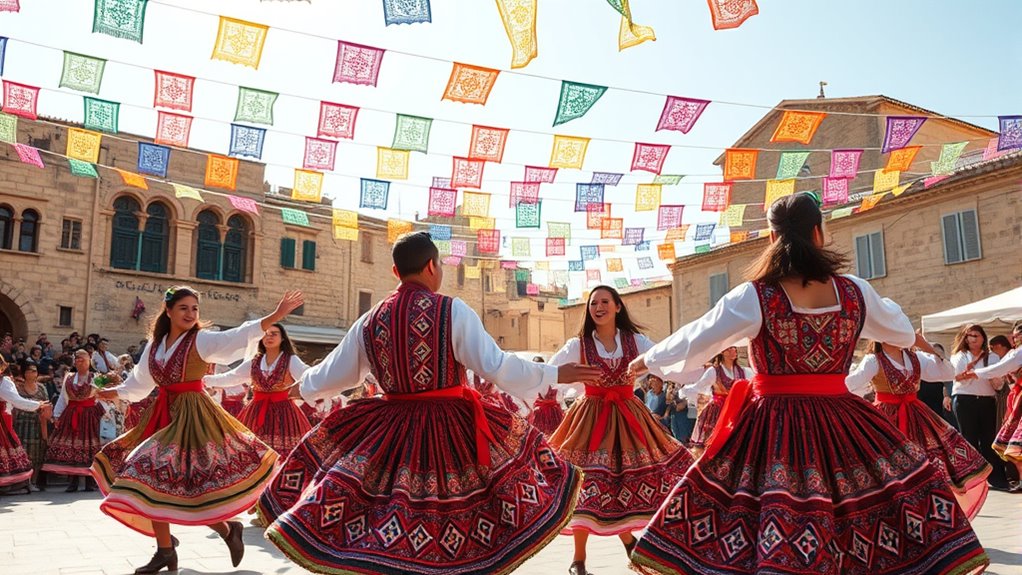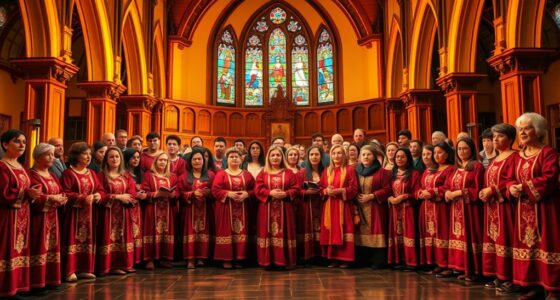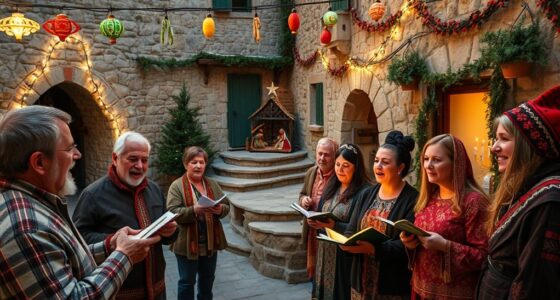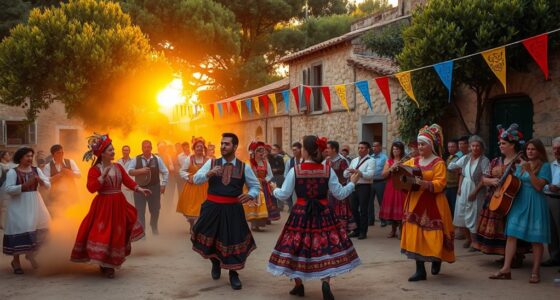The Ittiri Folk Festival, founded in 1972, celebrates Sardinian culture through music, dance, crafts, and traditions, attracting international performers and visitors. It originated from dance rehearsals and has grown into a major event that preserves regional identity, showcases Sardinian costume, and promotes cross-cultural exchange. The festival boosts local pride, supports tourism, and highlights Sardinia’s rich heritage rooted in ancient civilizations. Discover more about its vibrant history and cultural importance as you continue.
Key Takeaways
- Established in 1972 to promote Sardinian culture, originating from dance rehearsals for Nuoro Folklore Europeade.
- Celebrates traditional Sardinian customs, costumes, music, and crafts, serving as a platform for cultural preservation.
- Evolved into a major event attracting international folk groups, fostering cross-cultural exchange and community pride.
- Highlights Sardinian history from Nuragic civilization to modern traditions, linking past and present cultural identities.
- Significantly boosts local tourism and economy, showcasing Sardinian arts, crafts, and culinary traditions.
Origins and Founding of the Festival
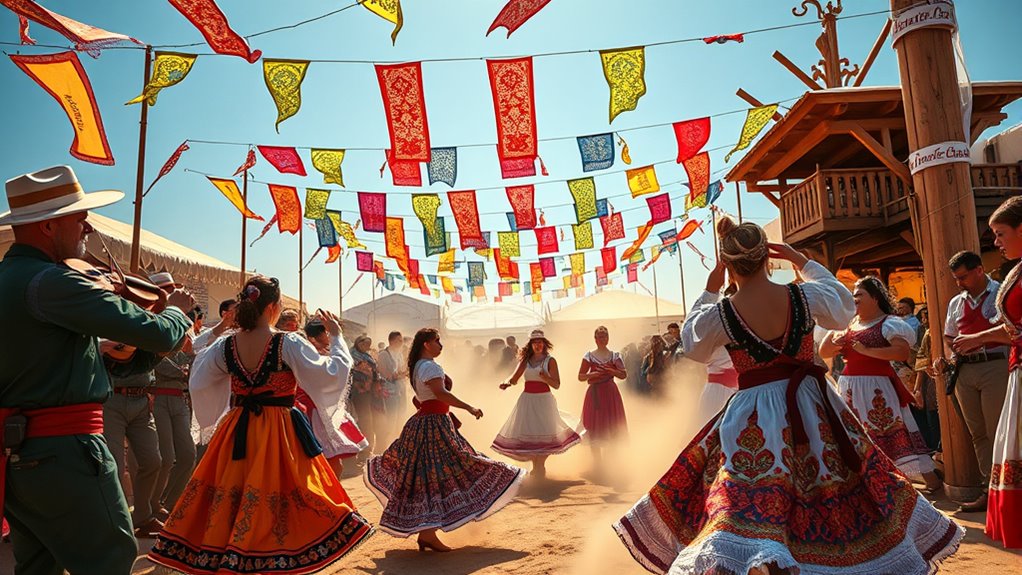
The Ittiri Folk Festival was founded in 1972 by the Ittiri Canneddu association, which aimed to recover and promote the traditional clothing and folk dances of the local community. You can see that it originated from dance rehearsals preparing for the Nuoro Folklore Europeade, marking the group’s first public appearance. Rooted in strong local enthusiasm, the festival aimed to preserve Sardinian culture through authentic dance and costumes. Initially, performances focused on traditional dances and crafts, engaging mainly local participants. As the festival gained recognition, it expanded to include international folk groups, creating a broader cultural network. Organized by Ittiri Canneddu, the festival’s founding principles emphasized hospitality, sharing, and safeguarding intangible heritage, establishing it as Sardinia’s longest-running international folk event. Since then, the festival has grown into a major cultural celebration that attracts visitors from around the world, fostering cultural exchange and understanding among diverse communities.
The Historical Roots of Ittiri and Its Cultural Heritage
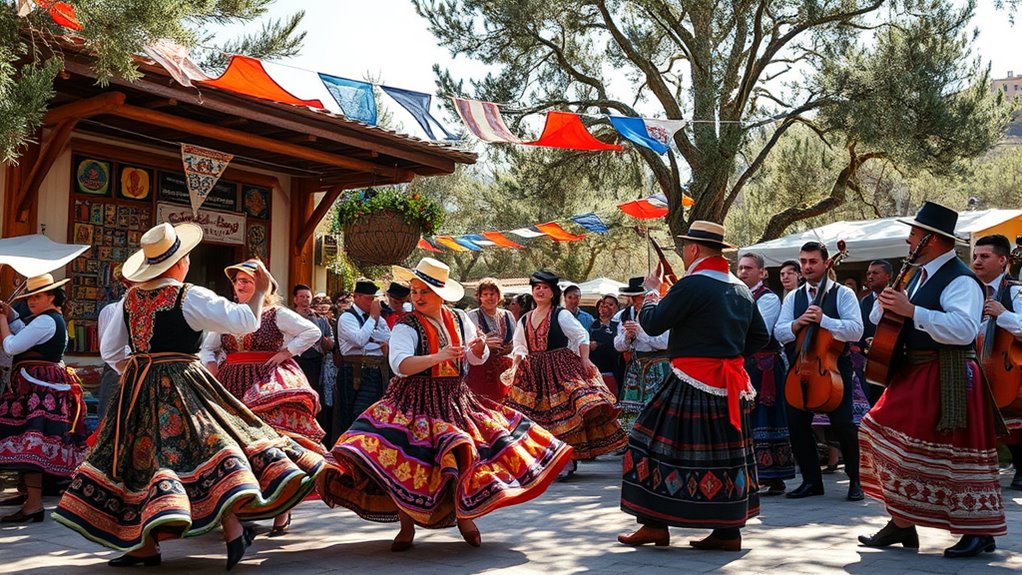
Ittiri’s rich cultural heritage is rooted in its ancient history and archaeological significance. Situated in the Coros region of Logudoro, it was inhabited by the Nuragic tribe called the Coracenes, mentioned by Ptolemy in the 2nd century CE. Over centuries, Libyans, Galatians, Etruscans, Phoenicians, Carthaginians, and Romans influenced the area, layering its culture. The Nuragic civilization thrived around 18th century BCE until the 6th century AD, leaving behind megalithic structures. Roman rule extended for about 700 years, shaping local traditions and infrastructure. Human presence in Ittiri dates back to the Paleolithic era, making it a site rich in archaeological treasures. The territory also features numerous pre-nuragic sites, such as dolmens and menhir alignments, indicating an even longer history of human settlement. These historical layers form the foundation of Iittiri’s enduring cultural identity, demonstrating a continuous human habitation through various periods.
Core Elements of the Festival Program
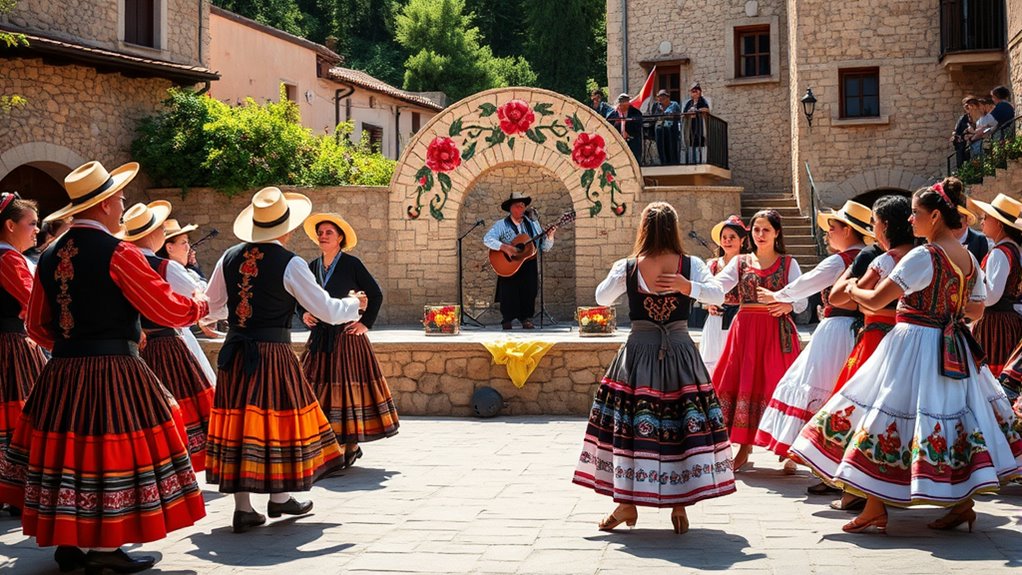
At the heart of the Ittiri Folk Festival, performances and cultural exhibitions come together to showcase Italy’s rich regional diversity and global traditions. You’ll experience performances by seven Italian folk groups, each representing unique regional customs, alongside three international acts and intercontinental groups that highlight worldwide folk traditions. Live dance, folk music, and singing form the core of the entertainment. The festival also features vibrant exhibitions of traditional folk art and crafts, demonstrating craftsmanship and cultural significance. Culinary demonstrations of Sardinian cuisine and local food stalls provide a taste of regional flavors. Additionally, historical reenactments like “La Pasionaria” and Sant’Arrasa deepen your understanding of local stories. These elements are staged across scenic venues, enriching your immersive festival experience. Incorporating remote hackathons can also be an innovative way for organizers to engage a global community in planning and sharing ideas for future editions.
Celebrating Sardinian and Global Folk Traditions
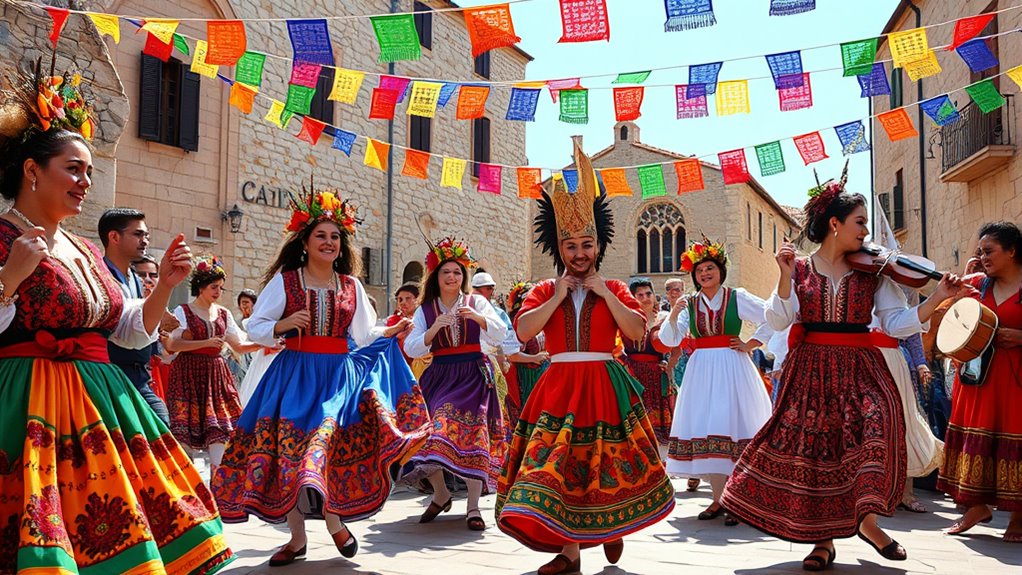
At the Ittiri Folk Festival, you see how Sardinian traditions are preserved and celebrated alongside vibrant international folk performances. Local artisans showcase their crafts, while global groups share their unique cultural expressions on stage. This lively exchange highlights the richness of both Sardinian and world folk traditions, fostering understanding and appreciation. The event also emphasizes the importance of soundscape in conveying cultural stories through music and performance.
Sardinian Cultural Heritage
Have you ever wondered how local traditions keep cultural identities vibrant across generations? In Ittiri, Sardinian heritage runs deep, shaped by centuries of history—from Nuragic tribes to Phoenicians, Romans, and beyond. The town’s architecture, with 11th-century churches and Romanesque influences, reflects this rich past. You can see Sardinian craftsmanship in embroidery, textile work, and trachyte stone sculptures, which remain essential today. Local artisans produce the elegant *S’estire Ruju* costumes, embodying regional pride. Culinary traditions thrive through regional dishes made from local olives and grapes, showcased during festivals. These cultural elements are preserved through museums, crafts, and festivals, ensuring Sardinian identity endures. The festival has grown in prominence over the years, Ittiri’s heritage is not just history; it’s a living, breathing part of everyday life. Additionally, the Sardinian cultural heritage continues to be celebrated through traditional music and dance, keeping the spirit of the past alive in modern festivities.
International Folk Engagement
The Ittiri Folk Festival has grown beyond celebrating Sardinian heritage to become a vibrant gathering that showcases folk traditions from around the world. Each year, it invites 7 national, 3 international, and 3 intercontinental folk groups, representing continents like South America, Europe, and the Middle East. Over four decades, performers from countries like Qatar and the Caucasus have graced its stages, making it a prestigious platform for global folk arts. Originally a local event, it evolved into an international cultural exchange, fostering mutual understanding through music, dance, and crafts. Sardinian groups also perform abroad, broadening the festival’s reach. Features over 100 events across Sardinia in 2025, this ongoing exchange highlights the festival’s role in preserving and innovating folk traditions on a worldwide scale. Additionally, the festival emphasizes the importance of cultural preservation by promoting traditional crafts and costumes alongside performances.
Traditional Arts Showcase
Celebrating both Sardinian and global folk traditions, the Ittiri Folk Festival showcases a rich array of traditional arts that connect communities to their cultural roots. You’ll see the preservation of Sardinian costumes, like the intricate female attire with silver buttons and ribbon lacing, still worn by elders and adapted into modern styles. Exhibitions display folk arts such as textile work, embroidery, and crafted objects, highlighting local techniques and symbolism. Traditional dance and theatrical performances animate the festival, with groups reviving ancient Sardinian dances and reenacting regional stories. Culinary demonstrations reveal recipes passed through generations, emphasizing local ingredients. These arts, along with historic architecture, forge a vibrant tapestry that celebrates Sardinian identity while embracing broader folk traditions. Vetted mother baby kids products also play a role in nurturing families and preserving cultural practices related to child-rearing.
The Festival’s Role in Promoting Local Identity
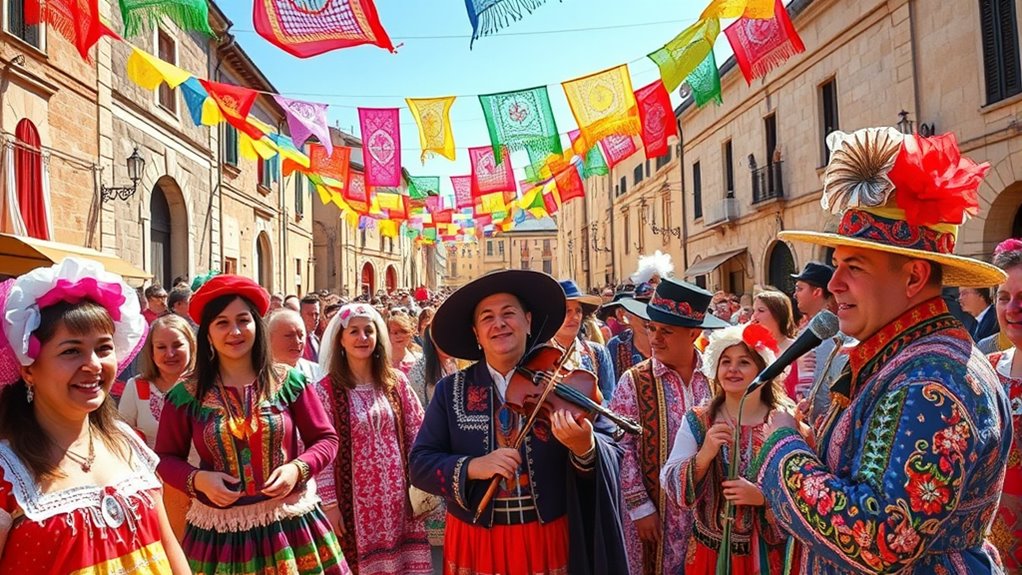
Attending the Ittiri Folk Festival allows you to experience firsthand how it actively preserves and promotes Sardinian culture. The festival celebrates traditional customs like the elegant S’estire Ruju costume, keeping regional attire alive. It strengthens community pride by showcasing local dances, music, and historical reenactments that reinforce shared heritage. Through displays of crafts such as embroidery and trachyte stone work, it guarantees artisanal skills are passed down and valued. The event connects generations, fostering social cohesion and deepening residents’ sense of identity. By embedding religious and historical traditions, the festival links community members to their roots. Additionally, the use of regional attire in performances and parades highlights the importance of traditional clothing in maintaining cultural identity. Overall, it elevates Ittiri’s regional uniqueness within Sardinia, making cultural pride and local identity central to its ongoing significance.
International Influence and Global Participation
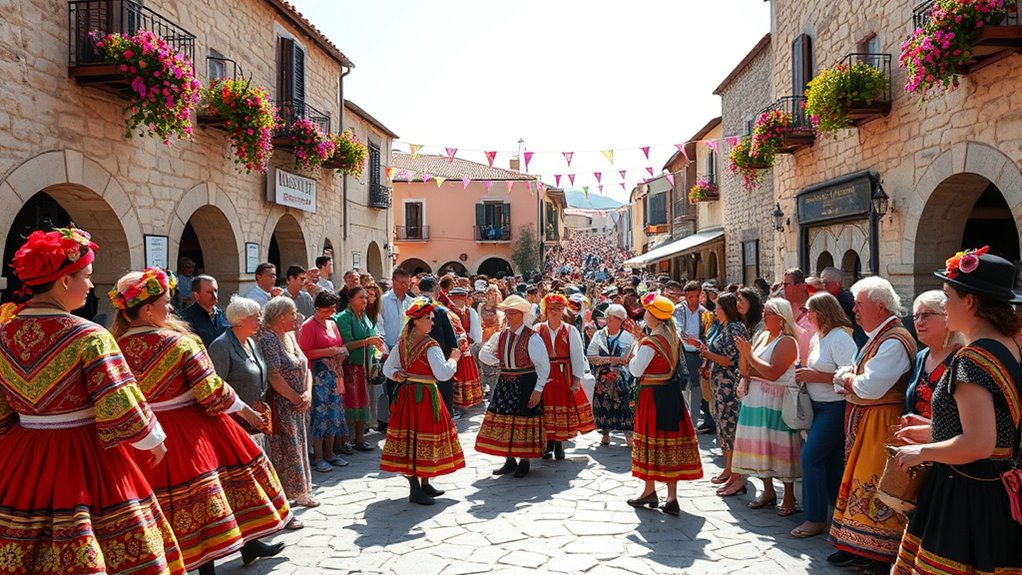
Have you ever wondered how the Ittiri Folk Festival has grown into a truly global event? It attracts diverse groups, including seven national, three international, and three intercontinental ensembles, representing countries from South America, Qatar, the Caucasus, and Germany. These groups showcase a variety of folk music, dance, and singing traditions, enriching the festival’s cultural tapestry. International participation isn’t new; since 1979, groups like Ittiri Cannedu have toured across Italy, Europe, and South America, fostering cultural exchanges and collaborations with Sardinian diaspora communities. The festival’s programming reflects global traditions through folk art, crafts, and stories from multiple continents. This diversity promotes cross-cultural dialogue, elevates its international reputation, and celebrates folk culture as a dynamic, evolving exchange. Cultural exchange remains a core element of the festival, encouraging ongoing dialogue and mutual understanding among diverse communities.
The Festival’s Impact on Tourism and Local Economy
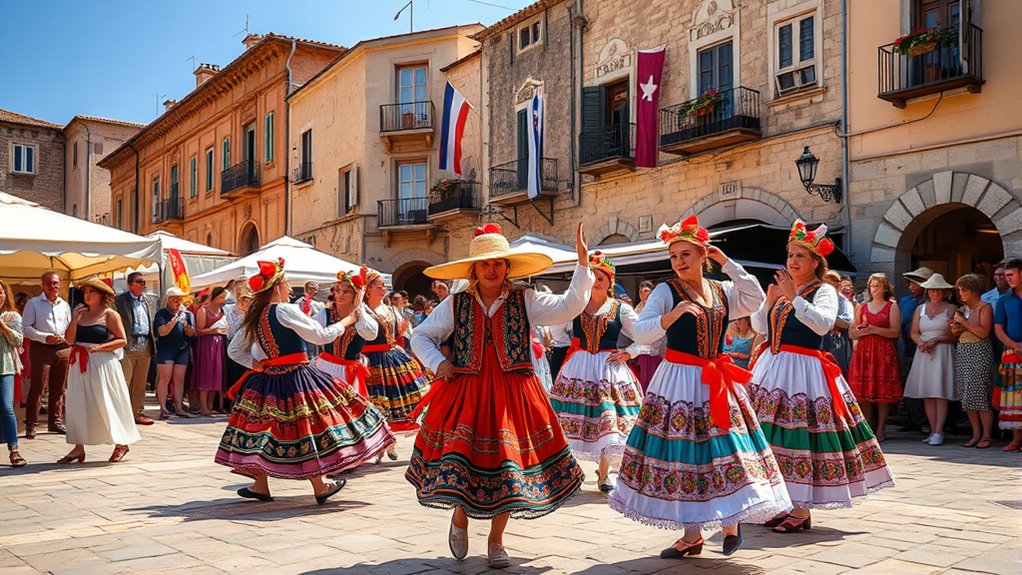
The Ittiri Folk Festival delivers a substantial boost to the local economy by drawing thousands of visitors from across Italy and beyond each July. Your spending during the event benefits hotels, restaurants, and artisan shops, encouraging longer stays and sustained revenue. Cultural sites like the Abbey of Nostra Signora di Paulis and local museums see increased foot traffic, boosting their visibility. The festival also promotes local products and crafts, such as Sardinian olive oil, prickly artichokes, and traditional folk art, creating sales opportunities for producers. Additionally, the event creates seasonal jobs in hospitality, event management, and cultural activities, supporting community employment. These enhancements often include new cultural attractions and improved transportation links, making the town more accessible and attractive for future visitors. Such improvements can also lead to a long-term increase in tourism, fostering ongoing economic development. Infrastructure improvements driven by the festival, like better signage and public spaces, further enhance Ittiri’s appeal and foster long-term tourism growth.
Connecting Sardinian Heritage With Broader Italian Traditions

Connecting Sardinian heritage with broader Italian traditions reveals a rich tapestry of shared history and cultural exchange, vividly showcased at the Ittiri Folk Festival. You’ll notice how ancient roots, like the Nuragic tribe Coracenes, intertwine with influences from Romans, Etruscans, and Phoenicians, creating a layered cultural landscape. The festival’s religious rituals, such as processions carrying saints’ statues, echo similar Italian traditions like the Sant’Efisio and Sa Sartiglia festivals. Sardinian folk costumes, with their distinctive silver buttons and vibrant ribbons, reflect local craftsmanship while aligning with Italy’s regional embroidery styles. The presence of ancient Nuragic sites nearby, such as the well-preserved Nuraghe Majore, underscores the deep historical roots of the region. These visual and ritual elements highlight how Sardinian and Italian cultures have evolved together, maintaining unique identities while sharing spiritual practices, craft traditions, and community celebrations that connect the island’s identity within Italy’s broader cultural mosaic.
The Festival’s Significance in the Cultural Landscape
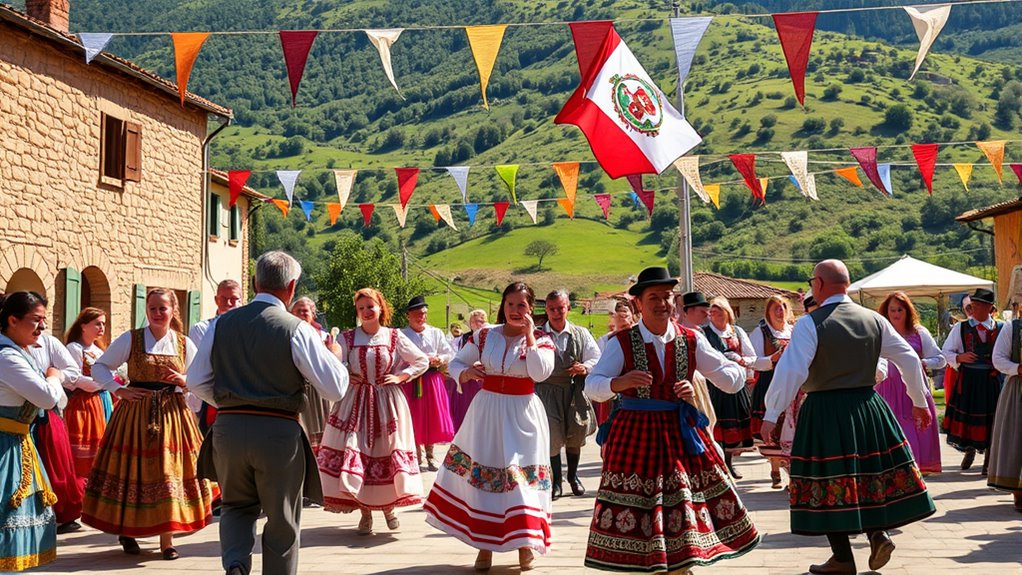
The Ittiri Folk Festival plays a essential role in strengthening Sardinian cultural identity, bringing communities together through shared traditions. It also bridges local customs with the wider world by welcoming international folk groups, fostering cultural exchange. This blend of local pride and global connection elevates Sardinia’s place in the broader cultural landscape.
Cultural Identity Reinforcement
Cultural identity finds a powerful expression during the Ittiri Folk Festival, as it actively preserves and promotes Sardinia’s rich traditions. The festival showcases folk dance, music, and singing that have been passed down through generations, reinforcing regional pride. Historical reenactments highlight Sardinian narratives, like the life of Toiedda Meloni and saint celebrations, deepening community roots. Exhibitions of local folk art and crafts support traditional artisanship, while regional cuisine celebrates culinary heritage. By inviting performers from across Sardinia’s provinces, the festival strengthens regional diversity and identity. You’ll see:
- Traditional costumes and rituals on display
- Local artisans showcasing crafts
- Community bonding in shared spaces
- Youth and elders participating together
- Celebrations of regional stories and saints
All these elements weave a vibrant fabric of Sardinian cultural pride and continuity. Additionally, the festival often features workshops and demonstrations that allow visitors to learn traditional crafts and dances firsthand, fostering a deeper connection to Sardinian cultural heritage.
International Cultural Exchange
Have you ever wondered how festivals can serve as bridges between diverse cultures? At the Ittiri Folk Festival, you experience this firsthand. Each year, you see folk groups from South America, Qatar, Caucasus, Europe, and beyond, sharing their music, dance, and traditions. This vibrant mix promotes intercultural dialogue, allowing artists and audiences to exchange techniques, stories, and histories. Workshops, exhibitions, and rehearsals deepen these connections, fostering mutual understanding. The festival also highlights endangered cultural practices, giving them international visibility. As Sardinia’s longest-running international event, it strengthens the island’s global cultural ties, boosts tourism, and projects a modern, inclusive image. Ultimately, you witness how the festival celebrates diversity, preserves traditions, and encourages creative collaboration across continents.
Frequently Asked Questions
How Has the Festival Evolved Since Its Inception in 1982?
Since its inception, you’ve seen the festival grow from a local Sardinian event to an international celebration. You notice it now features diverse folk music and dance styles, attracting global groups. You can attend workshops, reenactments, and exhibitions, with venues expanding to urban and green spaces. Over time, it’s become a vibrant platform for cultural exchange, blending tradition with modern influences, and fostering worldwide appreciation for Sardinian and global folk arts.
What Specific Traditional Sardinian Crafts Are Showcased at the Festival?
Like a tapestry woven with vibrant threads, the festival showcases Sardinian crafts you’ll find nowhere else. You’ll witness skilled textile work, traditional costumes with pink ribbons and silver buttons, and intricate embroidery. The craftsmanship extends to stone sculptures using pink trachyte, and the making of folk instruments like launeddas. Food artisans also display regional culinary skills, blending traditional ingredients into a rich cultural mosaic you won’t forget.
How Do International Folk Groups Influence Sardinian Cultural Preservation?
You see, international folk groups influence Sardinian cultural preservation by bringing diverse traditions that inspire local artisans and performers. Their performances encourage you to appreciate and maintain Sardinian customs while embracing new ideas. This exchange helps keep traditions alive, sparks innovation, and strengthens community pride. By blending global and local cultures, you’re part of a dynamic process that safeguards and revitalizes Sardinian heritage for future generations.
In What Ways Does the Festival Support Local Artisans and Musicians?
Think of the festival as a vibrant tapestry where local artisans and musicians weave their traditions into every thread. You see, it supports them by showcasing their crafts and performances, giving them a platform to reach new audiences. You can also buy handmade goods directly from artisans, helping their livelihoods. This lively exchange keeps local culture alive, fostering pride and ensuring these skills aren’t lost over time.
What Are the Main Challenges Faced in Maintaining the Festival’s Tradition?
You face challenges in keeping the festival’s tradition alive as global influences risk diluting local folk elements. Maintaining authentic dances, music, and rituals requires balancing innovation with tradition, which can be tough amid evolving programming. Limited documentation makes passing down oral heritage difficult, and organizing international groups strains resources. Financial constraints and attracting younger generations further complicate efforts to preserve and celebrate Ittiri’s rich cultural legacy.
Conclusion
Attending the Ittiri Folk Festival feels like stepping into a living tapestry of history and culture, where each dance and song weaves you closer to Sardinia’s soul. As locals share stories behind their vibrant costumes, you realize you’re part of a tradition that’s centuries old yet always evolving. This festival isn’t just an event; it’s a heartbeat connecting past and present, reminding you that preserving heritage is like tending a precious garden—nurtured with passion and care.
